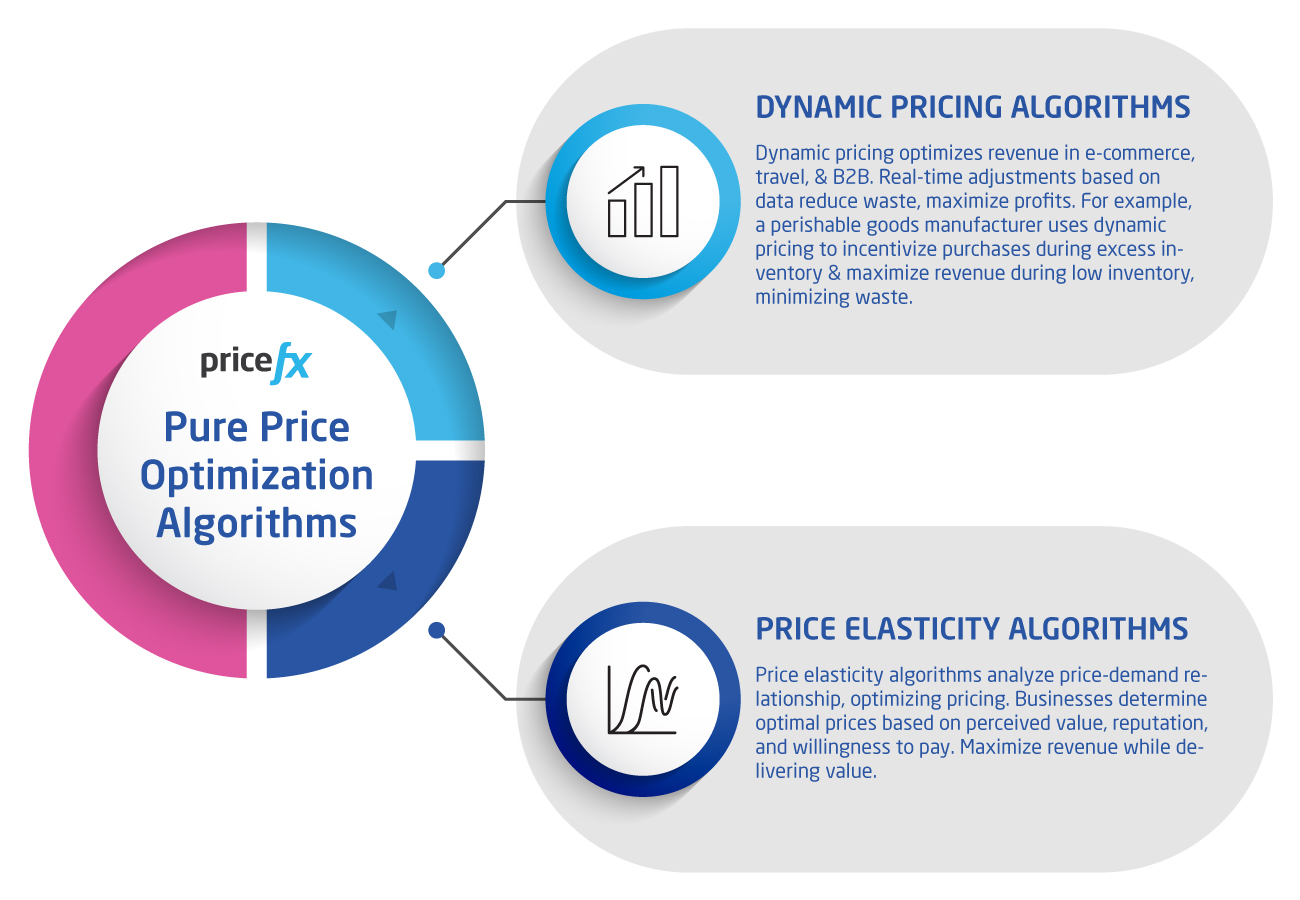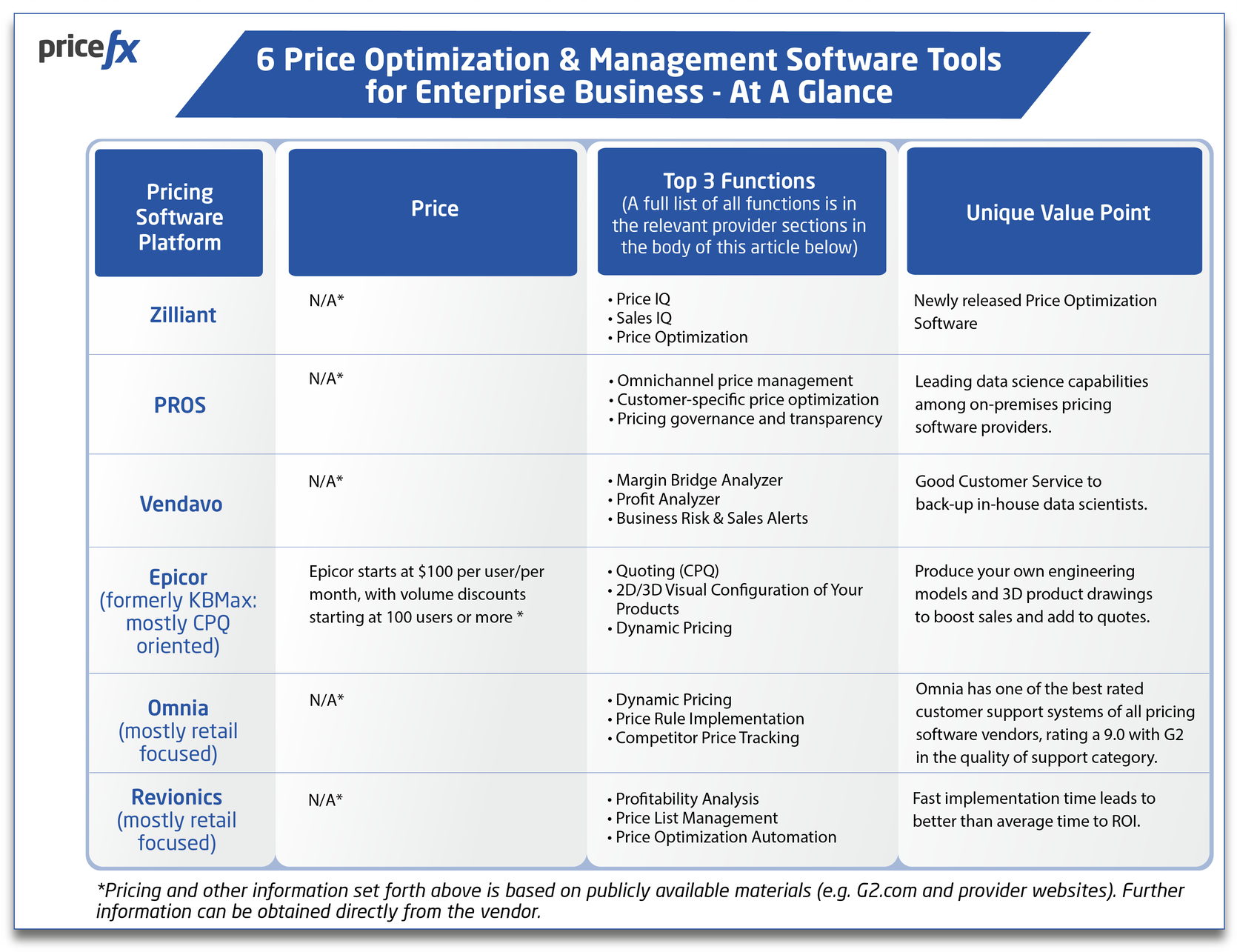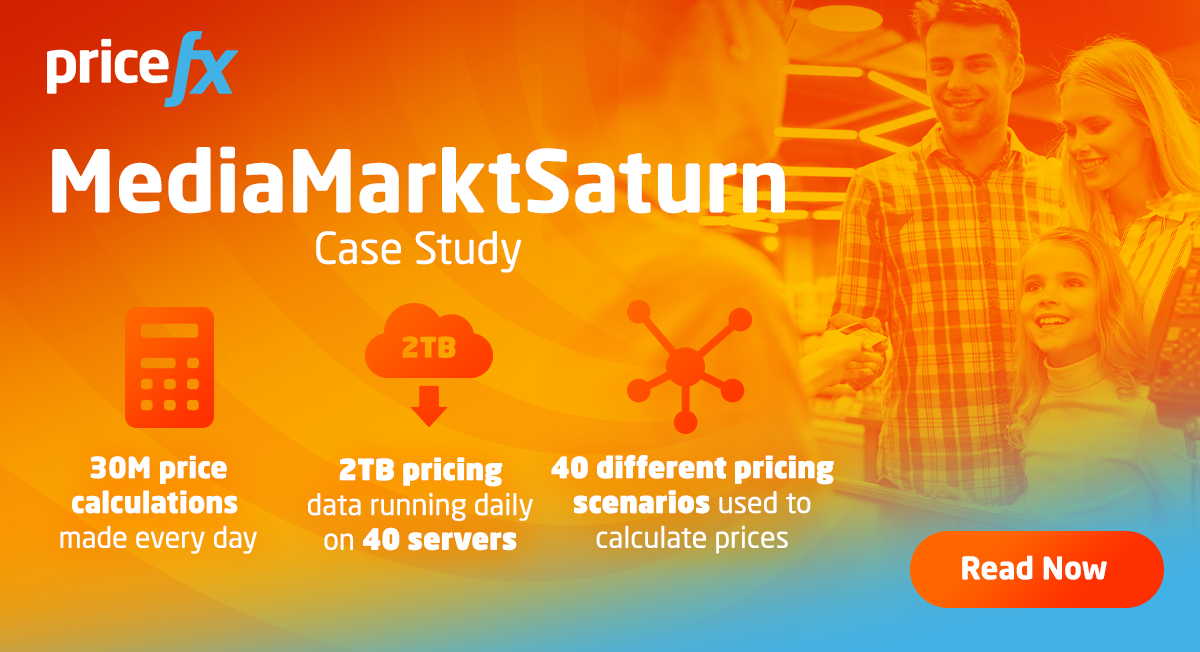Price Optimization Models & Techniques: An Introduction
August 10th, 2023 (Updated 08/11/2023) | 11 min. read
By Ken Edwards
Price Optimization Models can help businesses achieve their financial goals by recommending prices that maximize profits. By using these mathematical programs with the use of a quality price optimization software, companies can gain a better understanding of how demand for their products or services varies at different price points, as well as the impact of costs and inventory levels. Without them, finding the right price for the right customer at the right time could be mere guesswork. For instance, a manufacturer of industrial machinery may use a price optimization model to analyze data on past sales, inventory levels, and competitor pricing to determine the optimal price for their products and gain insights into customer behavior and demand trends to make more informed pricing decisions. By doing so, they can increase the likelihood of winning business while also maintaining profitability or achieving whatever else they might choose their unique business goals to be. Ultimately, using a price optimization model allows businesses to make data-driven decisions and optimize their pricing strategy for maximum financial gain.
For over a decade, Pricefx has supported numerous clients in optimizing pricing strategies, maximizing profits, and improving business efficiency. Our optimization software, built upon customized pricing algorithms and mathematical models, provides seamless integration with internal systems, ensuring the right price is delivered to the right person, for the right product, at the optimal time. Our clients have consistently benefited from our expertise in helping them capture the full value of their offerings, while enhancing their overall market competitiveness.
Let’s dive headfirst into explaining what price optimization models are exactly before analyzing techniques and methods that can transform that modeling into profit maximization, margin improvement or whatever your organization’s unique set of business objectives happen to be.
Price Optimization Models – The Definition & What they Do

Price optimization models are computer-based math programs that use data on consumer demand, pricing, costs, inventory, and other factors to suggest prices that maximize profits for businesses. These models have been in development for many years and have evolved with the help of machine learning (ML) and artificial intelligence (AI) technology, which has improved the accuracy of determining the optimal price. These models offer an efficient way for companies to set prices for their products or services without requiring extensive manual analysis.
By analyzing how demand changes at different price points and integrating this data with inventory and cost information, price optimization models can suggest pricing strategies that can increase profits. Price optimization models can also help businesses tailor their pricing to different customer segments by simulating how consumers will react to different price points.
Pricing Optimization Mathematical Models & Algorithms
Depending on a company’s overarching business objectives, the type of mathematical models used may vary. For the most part, price optimization is generally the most common, but it can vary. Consider the most common:
Pure Price Optimization Algorithms
Pricing optimization algorithms are computer programs that use mathematical models to optimize pricing strategies. These algorithms use market data, consumer behavior, and product demand to identify the optimal price point for a given product or service. Two commonly used pricing optimization algorithms are dynamic pricing algorithms and price elasticity algorithms:

- Dynamic Pricing Algorithms
Dynamic pricing algorithms are pricing optimization algorithms that adjust prices sometimes in real-time, (but also adjusting prices at a high frequency) based on market data and consumer behavior. These algorithms use machine learning techniques to analyze substantial amounts of data and identify pricing strategies that maximize revenue.
Dynamic pricing algorithms are most used in e-commerce, travel, hotel, and entertainment industries.
However, recently due to rising and continually fluctuating costs of raw materials and other elements of production, dynamic pricing is also becoming widespread in the B2B business environment too as a method of counteracting the volatility present in the marketplace.
For example, a food and beverage manufacturer that sells perishable goods could use dynamic pricing optimization models to adjust their pricing in real-time based on factors such as inventory levels, demand, and competition. If the business has excess inventory of a particular product, the model could automatically adjust the price downwards to incentivize customers to purchase more. Conversely, if inventory levels are low, the model could adjust the price upwards to maximize revenue while ensuring that demand is met. By using dynamic pricing optimization models, the distribution business can optimize their pricing strategy to maximize revenue and minimize waste.
- Price Elasticity Algorithms
Price elasticity algorithms are pricing optimization algorithms that analyze the relationship between product price and product demand. These algorithms use statistical methods to predict the effect of price changes on product demand.
For example, a company that offers marketing services to other businesses might use a price elasticity algorithm to determine the optimal pricing for their services based on the perceived value to their customers. For example, they could analyze how changes in their prices affect the demand for their services, considering factors such as the perceived quality of their services, their reputation in the market, and their customers’ willingness to pay for marketing services.
Using this data, the company could identify areas where they can increase prices without significantly impacting demand. For instance, they might find that increasing prices for their most comprehensive marketing package by 10% only results in a 5% decrease in demand, indicating that customers are willing to pay more for the additional value offered by this package. By using a price elasticity algorithm to determine the optimal pricing for each service package, the company can maximize their revenue while still delivering value to their customers.
It is Not Only About Profit – Price Optimization Models Can Do So Much More
Price optimization models can be used to achieve a range of business objectives beyond just maximizing profits. For instance, some companies may prioritize boosting revenue or market share, while others may prioritize enhancing customer satisfaction or minimizing waste. By setting up different optimization models that consider various objectives and constraints, companies can tailor their pricing strategies to achieve their desired outcomes.
Uber’s Use of Price Optimization Models

Depending on demand and seasonality, Uber on occasion uses an in-house price optimization model that prioritizes increasing the number of rides, rather than maximizing profits. This approach can help Uber attract more riders and increase market share, while still maintaining profitability.
MediaMarktSaturn’s – Use of Price Optimization Models – Powered by Pricefx
MediaMarktSaturn is the leading consumer electronics retailer in Europe, operating more than 1000 bricks-and-mortar stores and selling in its online shops in 14 countries across Europe. Here are some of the ways that MediaMarktSaturn uses Pricefx to optimize its pricing:
- Automated pricing: MediaMarktSaturn uses Pricefx to automate its pricing strategy. By using Pricefx’s automated pricing software, MediaMarktSaturn can adjust prices in real-time based on demand, competition, and other market factors. This helps MediaMarktSaturn be a competitive market player and maximize profits.
- Competitive analysis: MediaMarktSaturn uses Pricefx to analyze its competitors’ prices and adjust its own prices, offering competitive prices to its customers and remaining competitive in the market. MediaMarktSaturn matches its prices with those of its competitors but also leverages aligning its own online and offline prices too, meeting the needs of its customers all while establishing a holistic, 360-degree view of their buying habits.
- Price elasticity modeling: MediaMarktSaturn uses Pricefx to model price elasticity for its products. By modeling price elasticity, MediaMarktSaturn can determine how price changes impact product demand. This helps MediaMarktSaturn set prices to maximize profits and minimize the impact on demand.
- Scenario analysis: MediaMarktSaturn uses Pricefx to conduct scenario analysis for different pricing strategies. By using Pricefx’s scenario analysis tools, MediaMarktSaturn can test different pricing strategies and determine which strategy is most productive for the company..
- Real-time analytics: MediaMarktSaturn uses Pricefx’s real-time analytics to monitor their pricing strategy impacts. By monitoring its pricing strategy in real-time, MediaMarktSaturn can quickly identify and address any issues that arise on the fly.
To learn more about how MediaMarktSaturn uses Pricefx pricing software technology to optimize its prices, check out the full case study by clicking on the image below:
Techniques of Applying Price Optimization
Of course, you will need a helping hand from technology to get the price optimization job done, and that comes in the form of price optimization software. The technology can assist in tracking your results and continuously run your chosen model and optimize pricing.
Naturally, the price optimization tool you choose should be able to monitor your pricing versus competitors to ensure you stay competitive while also achieving your goals.
IMPORTANT FACT – WHAT PRICE OPTIMIZATION CANNOT DO!
Price Optimization Software cannot determine your company’s pricing strategy, nor can it set your business objectives.
But what it can do is to is to find the right balance between pricing a product or service to achieve your company objectives (whatever your business chooses those to be).
Here some pricing strategy techniques with real-word examples of applying pricing optimization for everyday business:
Apple’s Value-Based Pricing
Value-based pricing is a pricing strategy that sets prices based on the perceived value of a product or service to the customer. This pricing strategy considers the benefits and features of the product or service and the customer’s willingness to pay.
For example, Apple is a company that uses value-based pricing. Apple’s products are known for their high quality, innovative features, and premium price points.

By setting premium prices, Apple captures a significant share of the market by appealing to customers who are willing to pay for high-quality products with advanced features. Value-based pricing requires a deep understanding of customer needs and preferences and a thorough analysis of the product’s value proposition.
Hotels and Airlines Demand-Based Pricing
Demand-based pricing is a pricing strategy that sets prices based on consumer demand for a product or service. This pricing strategy considers factors such as seasonality, market trends, and consumer behavior to determine the optimal price point. Demand-based pricing is commonly used in industries such as hospitality, travel, and entertainment.
For example, hotels and airlines use demand-based pricing to adjust prices based on factors such as occupancy rates, time of year, and market demand. During peak travel seasons or holidays, prices are typically higher due to increased demand, while prices are lower during off-peak periods. Demand-based pricing requires a deep understanding of market trends and consumer behavior to identify pricing opportunities and adjust prices accordingly.
Walmart’s Competitor-Based Pricing
Competitor-based pricing is a pricing strategy that sets prices based on competitor pricing strategies. This pricing strategy considers the prices of competing products or services and adjusts prices accordingly to remain competitive. Competitor-based pricing is very commonly used in industries such as retail and consumer goods.
For example, Walmart is a company that uses competitor-based pricing and has even taken the concept a step further and reframed it as ‘everyday low pricing.’ Walmart’s pricing strategy is to offer lower prices than its competitors to attract price-sensitive customers. By consistently offering lower prices, Walmart has become a dominant player in the retail industry. Competitor-based pricing requires a thorough analysis of competitor pricing strategies and a willingness to adjust prices to remain competitive.
The Model is Less Important – Getting Price Optimization Done is Critical
Now you have a ‘101 Introduction’ into price optimization models and techniques, it may have become apparent that the method you use to get there is less important than getting the optimization job done. What is of prime importance and most critical is to utilize the power of price optimization and its insights for the benefit of your organization by whatever method, and get it done ASAP.
Naturally, an automated price optimization software solution is the easiest and fastest way to get there, but how can you choose which one is right for your company as a method to achieve your goals?
See the list below of 6 of the best price optimization software tools (outside of our own award-winning Pricefx optimization solution, Optian) and how they stack up.

However, to take a deeper dive into reviews of 6 of the best price optimization software vendors operating in the marketplace today (and how Pricefx directly stacks up against them), check out the handy article below:
On the other hand, if you have made up your mind that the Pricefx price optimization software solution is what your organization requires, contact one of our expert team members now.
Happy Pricing!


